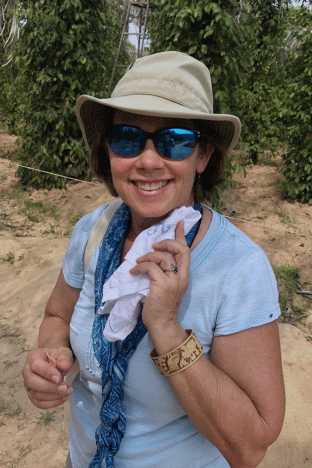
by Karen Telleen-Lawton, Noozhawk Columnist, Read the original column at Noozhawk.com
In one of my imagined alternate paths I would have become a cooking scientist or historian.
Our spice cupboards, gardens and refrigerators offer a wealth of history and chemistry lessons. What we consider basic food ingredients like sage and turmeric have histories rich in religious ritual and medicinals.
The spicier cuisines of the southern hemisphere are thought to reflect the preservative value of spices. Not, however, in temperate Santa Barbara.
Jan Timbrook, curator emeritus of ethnography at the Santa Barbara Museum of Natural History, believes it’s unlikely the Chumash carried plants or spices with them, other than perhaps as food for journeys.

“I don’t think there’s any botanical evidence for even accidental plant introduction at such an early date,” she wrote in an email to me. “Spices have never been on the menu in California Indian cuisine as far as I know.”*
Spices are pungent plant parts which contribute seasoning rather than nutrition to the cuisine. Both spices and herbs can enhance bland foods and transform standard recipes to the cook’s unique taste.
My cooking bible has been “The Joy of Cooking;” first edition published in 1931. Author Irma Rombauer describes the magic: “We know that seasonings, spices, herbs, and condiments can complement and compliment food, but it is our own sense of taste that composes the symphony.”
Rombauer suggests tasting throughout cooking because the process affects spices. Some spices like cayenne, paprika, and curry blends scorch easily and become bitter if overheated, so it’s imperative to heat seasoned food with care.
Other important seasoning tips from JOC include:
- Begin with the built-in flavors of food grown in rich soils and animals raised on rich vegetation;
- Add intensity to herbs and seeds like cumin, coriander, anise, caraway, and poppy by cracking, toasting, mincing, or crushing them to release essential oils and aroma.
- Use mint’s high menthol content to cool spicy foods;
- Experiment with seasoning combinations. For instance, salt can make sugar less cloying and tone down acidity; sugar or vinegar may reduce saltiness; and ginger can soften the strong flavor in fish and wildfowl. Salt, pepper, parsley act as catalysts for other flavors.
Spice production and use have long since spread worldwide, but climate disruption will affect their production and characteristics into the future. High temperatures can affect the flavor, aroma, and chemical composition of spices like black pepper. Changing rain and wind patterns are already affecting the cultivation of some spices like cardamom and vanilla.
My kitchen garden is limited to what I can keep from deer, gophers, and ground squirrels, plus being tolerant of neglect by travel. Our guests are often tasting an experiment of one sort or another, from California pho to Cincinnati chili a la Santa Barbara.
The last few years I’ve been brewing kambucha, fermenting kefir, and brining nasturtium fruit for capers. My dog-eared and spattered “Joy of Cooking” is never far away. “Joy’s” 88-page “Know your Ingredients” section is where I turn most often for spicy knowledge.
*A non-spicy side note: Dr. Timbrook pointed out an error in my last column, where I wrote that Chumash have paddled their traditional tomols for over 13,000 years. Timbrook says the Chumash ancestors had made this area home for thousands of years before inventing the tomol plank canoe around 1000-1500 years ago.
The migrators “wouldn’t have needed strong, seaworthy boats but could have used some form of log rafts. Dugout canoes and tule-bundle balsa boats were probably developed later in prehistory, and plank canoes last of all.”

Karen Telleen-Lawton, Noozhawk Columnist
Karen Telleen-Lawton is an eco-writer, sharing information and insights about economics and ecology, finances and the environment. Having recently retired from financial planning and advising, she spends more time exploring the outdoors — and reading and writing about it. The opinions expressed are her own.

